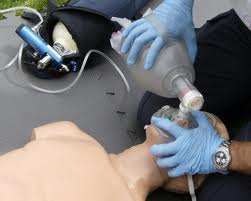Bag Valve Mask

A bag valve mask (BVM), also known by the trademarked name Ambu bag, is a
handheld apparatus utilized to administer positive pressure ventilation to a
patient experiencing inadequate breathing or complete cessation of breath.
It is an essential component of resuscitation kits for trained medical
professionals, including ambulance crews, and is commonly found in hospitals
as part of crash carts. Moreover, it plays a crucial role in operating rooms
to ventilate patients under anesthesia prior to connection to a mechanical
ventilator. The BVM can self-fill with air, but supplementary oxygen (O2)
can also be introduced.
The act of using the BVM to provide ventilation to a patient is often
referred to as "bagging" the patient. This technique is frequently employed
during medical emergencies characterized by respiratory failure or arrest.
The BVM comprises a flexible air chamber (resembling the size of an American
football) connected to a face mask via a shutter valve. Proper application
of the face mask and squeezing the chamber forces air into the patient's
lungs, while releasing the chamber allows it to self-inflate from the other
end, drawing in ambient air or low-pressure oxygen supplied from a regulated
cylinder.
Bag and valve configurations can alternatively be affixed to an alternate
airway adjunct, such as an endotracheal tube or laryngeal mask airway, often
accompanied by a small HME filter (Heat & Moisture Exchanger or
humidifying/bacterial filter).
A bag valve mask can function without being attached to an oxygen tank,
delivering air to the patient, commonly referred to as "room air" in the
U.S. The addition of supplemental oxygen enhances the oxygen partial
pressure inhaled, aiding in improving patient perfusion.
Most BVMs incorporate a reservoir that fills from an oxygen source during
the patient's exhalation phase, thereby increasing the oxygen delivery to
nearly 100%.
Available in various sizes for infants, children, and adults, the mask size
may not necessarily correlate with the chamber size. For instance, a single
pediatric-sized chamber may be paired with different masks to accommodate
various face sizes, or a pediatric mask may be used with an adult-sized
chamber for patients with smaller facial features.
While some types of BVMs are designed for single-use and disposable, others
are constructed to be cleaned and reused. The functioning of a BVM relies on
a one-way valve that directs gas flow when compressed by a rescuer,
delivering it into the patient's trachea, bronchi, and lungs. Adequate
ventilation requires the delivery of 500 to 800 milliliters of air to an
adult patient's lungs, ensuring that the patient's chest rises with each
inhalation.
To ensure efficacy, professional rescuers are trained to ensure proper
sealing of the mask around the patient's face, commonly referred to as "mask
seal." This may necessitate the assistance of two rescuers, one focusing on
holding the mask to the patient's face while the other operates the bag.
However, in circumstances where only one rescuer is available, the BVM can
be operated single-handedly with the rescuer holding the mask to the
patient's face and operating the bag with the other hand.
While using a BVM, there is a risk of over-inflating the lungs, potentially
leading to lung damage or gastric distension. Some models of BVMs are
equipped with valves to prevent over-inflation. Additionally, the
application of cricoid pressure (Sellick maneuver) may be employed to
minimize the risk of aspiration of gastric contents.
In hospitals, long-term mechanical ventilation is administered through
automated devices like intensive care ventilators, rather than by BVMs,
which require constant manual operation.
undo Medical Equipment